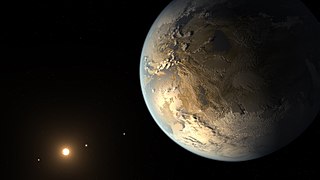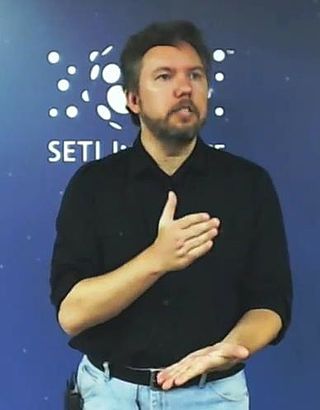Related Research Articles

An exoplanet or extrasolar planet is a planet outside the Solar System. The first possible evidence of an exoplanet was noted in 1917 but was not then recognized as such. The first confirmation of the detection occurred in 1992. A different planet, first detected in 1988, was confirmed in 2003. As of 1 April 2024, there are 5,653 confirmed exoplanets in 4,161 planetary systems, with 896 systems having more than one planet. The James Webb Space Telescope (JWST) is expected to discover more exoplanets, and to give more insight into their traits, such as their composition, environmental conditions, and potential for life.

These are lists of planets. A planet is a large, rounded astronomical body that is neither a star nor its remnant. The best available theory of planet formation is the nebular hypothesis, which posits that an interstellar cloud collapses out of a nebula to create a young protostar orbited by a protoplanetary disk. There are eight planets within the Solar System; planets outside of the solar system are also known as exoplanets.

Gravitational microlensing is an astronomical phenomenon caused by the gravitational lens effect. It can be used to detect objects that range from the mass of a planet to the mass of a star, regardless of the light they emit. Typically, astronomers can only detect bright objects that emit much light (stars) or large objects that block background light. These objects make up only a minor portion of the mass of a galaxy. Microlensing allows the study of objects that emit little or no light.

WASP or Wide Angle Search for Planets is an international consortium of several academic organisations performing an ultra-wide angle search for exoplanets using transit photometry. The array of robotic telescopes aims to survey the entire sky, simultaneously monitoring many thousands of stars at an apparent visual magnitude from about 7 to 13.

OGLE-2005-BLG-390Lb is a super-Earth exoplanet orbiting OGLE-2005-BLG-390L, a star 21,500 ± 3,300 light-years from Earth near the center of the Milky Way, making it one of the most distant planets known. On January 25, 2006, Probing Lensing Anomalies NETwork/Robotic Telescope Network (PLANET/Robonet), Optical Gravitational Lensing Experiment (OGLE), and Microlensing Observations in Astrophysics (MOA) made a joint announcement of the discovery. The planet does not appear to meet conditions presumed necessary to support life.

The Optical Gravitational Lensing Experiment (OGLE) is a Polish astronomical project based at the University of Warsaw that runs a long-term variability sky survey (1992–present). The main goals are the detection and classification of variable stars, discovery of microlensing events, dwarf novae, and studies of the structure of the Galaxy and the Magellanic Clouds. Since the project began in 1992, it has discovered a multitude of extrasolar planets, together with the first planet discovered using the transit method (OGLE-TR-56b) and gravitational microlensing. The project has been led by professor Andrzej Udalski since its inception.

Any planet is an extremely faint light source compared to its parent star. For example, a star like the Sun is about a billion times as bright as the reflected light from any of the planets orbiting it. In addition to the intrinsic difficulty of detecting such a faint light source, the light from the parent star causes a glare that washes it out. For those reasons, very few of the exoplanets reported as of January 2024 have been observed directly, with even fewer being resolved from their host star.

OGLE-2006-BLG-109L is a dim magnitude 17 M0V galactic bulge star approximately 4,920 light-years away in the constellation of Scorpius.
RoboNet-1.0 was a prototype global network of UK-built 2-metre robotic telescopes, the largest of their kind in the world, comprising the Liverpool Telescope on La Palma, the Faulkes Telescope North on Maui (Hawaii), and the Faulkes Telescope South in Australia, managed by a consortium of ten UK universities under the lead of Liverpool John Moores University. For the technological aims of integrating a global network to act effectively as a single instrument, and maximizing the scientific return by applying the newest developments in e-Science, RoboNet adopted the intelligent-agent architecture devised and maintained by the eSTAR project.

OGLE-2006-BLG-109Lc is an extrasolar planet approximately 4,925 light-years away in the constellation of Sagittarius. The planet was detected orbiting the star OGLE-2006-BLG-109L in 2008 by a research team using Microlensing. The host star is about 50% the mass of the Sun and the planet is about 90% the mass of Saturn.
OGLE-2006-BLG-109Lb is an extrasolar planet approximately 4,920 light-years away in the constellation of Sagittarius. The planet was detected orbiting the star OGLE-2006-BLG-109L in 2008 by a research team using Microlensing.
An extragalactic planet, also known as an extragalactic exoplanet or an extroplanet, is a star-bound planet or rogue planet located outside of the Milky Way Galaxy. Due to the immense distances to such worlds, they would be very hard to detect directly. However, indirect evidence suggests that such planets exist. Nonetheless, the most distant known planets are SWEEPS-11 and SWEEPS-04, located in Sagittarius, approximately 27,710 light-years from the Sun, while the Milky Way is about 87,400 light-years in diameter. This means that even galactic planets located further than that distance have not been detected.
The Microlensing Follow-Up Network is an informal group of observers who monitor high magnification gravitational microlensing events in the Milky Way's Galactic Bulge. Its goal is to detect extrasolar planets via microlensing of the parent star by the planet. μFUN is a follow-up network - they monitor microlensing events identified by survey groups such as OGLE and Microlensing Observations in Astrophysics (MOA).

An exoplanet is a planet located outside the Solar System. The first evidence of an exoplanet was noted as early as 1917, but was not recognized as such until 2016; no planet discovery has yet come from that evidence. What turned out to be the first detection of an exoplanet was published among a list of possible candidates in 1988, though not confirmed until 2003. The first confirmed detection came in 1992, with the discovery of terrestrial-mass planets orbiting the pulsar PSR B1257+12. The first confirmation of an exoplanet orbiting a main-sequence star was made in 1995, when a giant planet was found in a four-day orbit around the nearby star 51 Pegasi. Some exoplanets have been imaged directly by telescopes, but the vast majority have been detected through indirect methods, such as the transit method and the radial-velocity method. As of 1 April 2024, there are 5,653 confirmed exoplanets in 4,161 planetary systems, with 896 systems having more than one planet. This is a list of the most notable discoveries.

Stephen Kane is a full professor of astronomy and planetary astrophysics at the University of California, Riverside who specializes in exoplanetary science. His work covers a broad range of exoplanet detection methods, including the microlensing, transit, radial velocity, and imaging techniques. He is a leading expert on the topic of planetary habitability and the habitable zone of planetary systems. He has published hundreds of peer reviewed scientific papers and has discovered/co-discovered several hundred planets orbiting other stars. He is a prolific advocate of interdisciplinarity science and studying Venus as an exoplanet analog.

Denise C. Nuttall Stephens is an associate professor of astronomy in the College of Physical and Mathematical Sciences in the Department of Physics and Astronomy at Brigham Young University.
References
- ↑ Scupham-bilton, Tony (August 19, 2018). "The Queerstory Files: Star-Gayzing ... To Seek Out New Worlds". The Queerstory Files. Retrieved April 26, 2022.
- ↑ Mann, Adam. "New Revelations Raise Pressure on NASA to Rename the James Webb Space Telescope". Scientific American. Retrieved April 26, 2022.
- ↑ Gaudi, B. S. (2008). "Discovery of a Jupiter/Saturn Analog with Gravitational Microlensing". Science. 319 (5865): 927–930. arXiv: 0802.1920 . Bibcode:2008Sci...319..927G. doi:10.1126/science.1151947. PMID 18276883. S2CID 119281787.
- ↑ Scott Gaudi, B.; et al. (January 1, 1970). "Planet is 'hotter than most stars' – BBC News". Nature. 546 (7659): 514–518. arXiv: 1706.06723 . Bibcode:2017Natur.546..514G. doi:10.1038/nature22392. PMID 28582774. S2CID 205256410 . Retrieved June 6, 2017.
- ↑ Weed, William (October 1, 2000). "20 Young Scientists to Watch". Discover Magazine.
- ↑ Gaudi, Scott (October 23, 2013). "Exploring New Planets". TEDxColumbus.